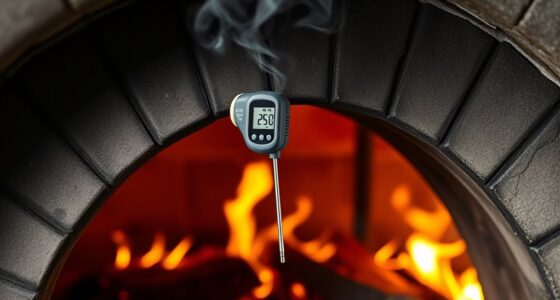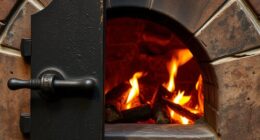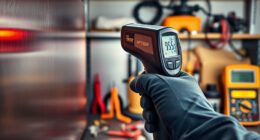Before cleaning your oven, you should allow it to cool completely to prevent burns and avoid damaging the appliance. Wait at least 30 minutes after turning it off, and keep the door closed during this time. Rushing to clean while it’s still hot can cause splatters, burns, or harm sensitive electronic parts. Ensuring proper cooling helps keep you safe and maintains your oven’s longevity—continue to learn how to do it right and stay safe.
Key Takeaways
- Wait at least 30 minutes after turning off the oven to allow it to cool completely.
- Keep the oven door closed during the cooling period to prevent heat from escaping prematurely.
- Avoid opening the door too early to prevent burns from hot air and residual heat.
- Proper cooling prevents damage to oven components and extends the appliance’s lifespan.
- A fully cooled oven ensures safer, more effective cleaning without risk of injury.

Before you begin cleaning your oven, it’s vital to make sure it has cooled completely to prevent burns or accidents. Oven safety should always come first, especially when dealing with hot surfaces and potentially hazardous cleaning agents. Rushing into cleaning a hot oven can lead to serious injuries, so taking the time to wait until it’s cool is a smart move. Not only does this protect you, but it also guarantees you’re working in a safe environment where you can focus on thoroughly cleaning without the risk of burns. Creating a consistent cleaning schedule can help you avoid the buildup of grease and grime, making the process quicker and safer each time. Waiting for the oven to cool down is a key step in maintaining this schedule effectively.
Once you turn off your oven, give it enough time to cool naturally. The cooling process varies depending on the oven’s size and how long it’s been in use, but generally, waiting at least 30 minutes is advisable. If you’re in a hurry, you might be tempted to open the door sooner, but resist that urge. Opening the oven prematurely can cause hot air and residual heat to escape rapidly, potentially leading to burns or splatters of hot grease. Instead, leave the door closed during this cooling period. Keep in mind that oven safety isn’t just about avoiding injuries; it also involves preventing damage to the appliance itself. For example, sudden temperature changes or the introduction of cleaning agents on a hot surface can harm some oven components. Additionally, microprocessors and specialized hardware are crucial for the proper functioning of arcade machines, highlighting the importance of handling appliances carefully during maintenance.
Having a regular cleaning schedule is also vital to oven safety. When you clean your oven often, less grime and grease accumulate, making the cleaning process safer and easier. A consistent schedule means you won’t have to use aggressive scrubbing or harsh chemicals to remove stubborn stains—both of which can pose safety risks if used improperly on hot surfaces. Waiting until the oven is completely cooled before cleaning ensures you won’t accidentally burn yourself or damage the appliance. It also allows you to work more efficiently, as you can focus on scrubbing away residue without the distraction of heat or discomfort. By incorporating a cooling step into your routine, you reinforce safe cleaning habits, prolong your oven’s lifespan, and maintain a hygienic cooking environment.
Frequently Asked Questions
How Long Should I Wait Before Cleaning My Oven After Cooking?
You should wait at least 30 minutes after cooking before cleaning your oven, especially if it was at a high oven temperature. This allows the oven to cool down properly, making cleaning safer and more effective. Incorporate this into your regular cleaning schedule to prevent damage or burns. Always verify the oven is cool before wiping down surfaces or using cleaning products, keeping safety and maintenance in check.
Can I Clean My Oven Immediately After It Shuts Off?
Did you know that cleaning your oven immediately after it shuts off can be risky? You shouldn’t clean it right away because of oven safety concerns; the oven remains hot for a while. For your cleaning schedule, wait at least 30 minutes to let it cool down. This prevents burns and damage, ensuring safe, effective cleaning. Always prioritize safety before tackling your oven’s messes.
What Are Signs That the Oven Is Cool Enough to Clean?
You’ll know your oven is cool enough to clean when it feels room temperature to the touch and the surface isn’t emitting heat. For oven safety, wait at least 30 minutes after turning it off, especially if it’s been used heavily. Use cleaning tips like checking the thermometer or touch test. Always prioritize safety to avoid burns and damage, making your cleaning process safer and more effective.
Is It Safe to Open the Oven Door During the Cooling Process?
Opening the oven door during the cooling process is like opening a treasure chest too soon—you risk burns from residual heat. For oven door safety, follow the cooling process guidelines, which advise waiting until the oven is fully cooled before opening it. This prevents accidents and keeps you safe. Always check the oven’s surface temperature, and don’t rush—patience guarantees a safe, smooth cleaning experience.
How Can I Tell if My Oven Has Cooled Sufficiently?
You can tell your oven has cooled sufficiently by checking its temperature with an oven thermometer or touch. Aim for an oven temperature below 100°F (38°C) or when safety indicators, like the surface feeling cool to the touch, are present. Always wait until the oven’s exterior feels cool and the internal temperature drops, ensuring it’s safe to clean without risking burns or damage.
Conclusion
Remember, safety starts with patience. Let the oven cool before cleaning, let the heat fade before the scrub, and let your caution guide your actions. Rushing risks burns, damage, and injury. By waiting for the oven to cool, you protect yourself, preserve your appliance, and ensure peace of mind. Stay mindful, stay safe, and let the cooling process remind you that a cautious approach leads to confident cleaning and lasting results.









